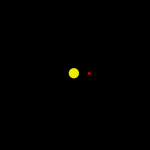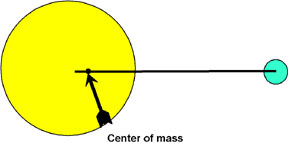 Imagine that we measure
the spectrum of a star and see it is moving towards us (blue shifted).
A couple of years later, we look at the spectrum and it's red
shifted! And a couple of years after that we look at the star and it's
blue shifted again!
What is going on here? How can a star move
towards us sometimes and away from us a few years later? That's
crazy -- how can we explain this?
Imagine that we measure
the spectrum of a star and see it is moving towards us (blue shifted).
A couple of years later, we look at the spectrum and it's red
shifted! And a couple of years after that we look at the star and it's
blue shifted again!
What is going on here? How can a star move
towards us sometimes and away from us a few years later? That's
crazy -- how can we explain this?
We all "know" that our Sun is the center of our solar system and all the planets revolve around the center of the Sun (Earth does it in 365 days - our year), right? Well, not quite. 99%+ of all the mass in the solar system is the Sun and we can say that, pretty much, the center of the mass of OUR solar system is the center of the Sun.
Now let's imagine a star that has one big, humungous planet in orbit about it. Let's also imagine that the big planet is orbiting close to that star. We usually think, since stars are SO much more massive than planets, that all the planets revolve about the center of star. In our imagined star system, though, the BIG planet's mass is a fair percentage of the mass of the star. What happens in this case is interesting. Both the planet and the star revolve about the center of mass of the two of them. And this center if mass is not exactly at the star's center.
Center of Mass?
Picture this star and it's big planet. Think of them as a bowling ball and, a couple of feet away, a baseball. Think of drawing a line from the center of the bowling ball (its center of mass) through the center of the baseball (its center of mass). Somewhere along this line will be the center of mass of the two together. Since the bowling ball (our star) is WAY more massive than our baseball (our BIG planet), the center of mass of the system is somewhere inside the bowling ball!. In our imaginary star/planet system, both the star and the planet are both orbiting about their common center of mass. To us, the planet looks pretty normal orbiting around in a circle (an ellipse, actually) but the star looks really weird! IT WOBBLES! It is also orbiting in a "circle" but the center of that circle is inside the star!
We astronomers (yup, you are an astronomer) here on Earth take a look at our imaginary star system and, guess what, we can't see it wobble. Stars are WAY too far away for even our best telescopes to see planets or see a star wobble. BUT, because of the wobble, half the time most of the star is moving towards us and the other half the time most of the star is moving away from us. This we can see in the Fraunhofer lines -- periodically, the spectral lines are shifted a tiny bit to the red end, then a tiny bit to the blue end. This is how, in the last few years, astronomers have discovered hundreds of planets around other stars!
Just so you aren't mislead. Our Sun does wobble because of the planets in orbit about it, but the wobble is VERY tiny and complicated (remember, our Sun has 9 small-ish planets, not one big one). An alien astronomer from a nearby star and using a good telescope might be able to figure out that our Sun has planets, how many, how big, and how far away from the Sun. Thank you Fraunhofer lines!
By the way, you just did something very important. You did an experiment entirely in your head! This is called a "gedunken" or "thought experiment". Lots of important science can't easily be done in a laboratory and has to be done in your head. Albert Einstein figured out most of the Theory of Relativity by doing gedunken experiments. You and Einstein have a lot in common!